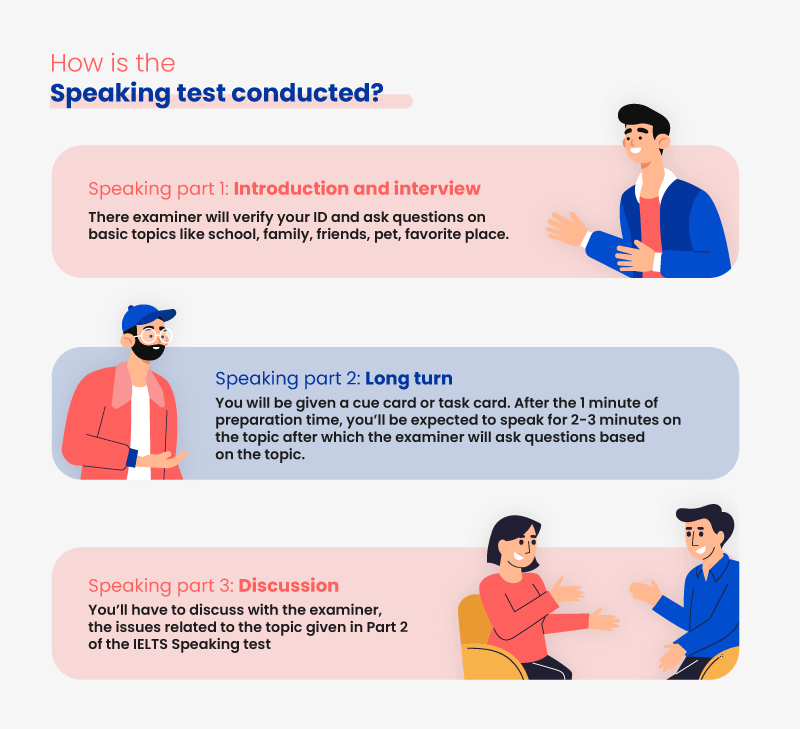IELTS Speaking – All about Speaking test, Essential tips
“The IELTS speaking test is a face-to-face discussion with the IELTS examiner who will be evaluating you. IELTS speaking test is common for both academic and general which tests your real-life speaking skills.“
IELTS Speaking module is the last part of the IELTS examination. The test consists of 3 parts and involves having a conversation of around 15 minutes with the examiner. IELTS Speaking Part 1 is a conversation that will be based on a general theme like your childhood, school, family, friends, and so on. You must talk confidently and frame your sentences the right way while speaking. In IELTS Speaking Part 2 the examiner will give you a cue card or a task card based on which you’ll be asked to talk about. You will be given 1 minute to prepare for the answer. In IELTS Speaking Part 3 the examiner will ask you in-depth questions related to the topic given in part 2 of the IELTS examination. The speaking test will be the same for the Academic and General training section.
Mục Lục
Test Format for IELTS Speaking
IELTS speaking test duration: This test duration will be around 12-14 minutes, and the entire test will be recorded. 
Speaking Test Part 1 – Introduction and Interview
This test lasts for 4-5 minutes and it’ll start with you having to introduce yourself after which the examiner will introduce himself/herself to you, so you both know each other’s identity. The examiner will then question you on some familiar basic topics like school, family, friends, pet, favorite place and so on. This is to check your ability to communicate the ideas and information on everyday topics.
Speaking Test Part 2 – Long Turn
In this part, the examiner will give you a cue card in which a topic will be mentioned. You’ll then be given 1 minute to practice for the answer and also be provided with a pencil and paper to note down the important points. After the 1 minute of preparation time, you’ll be expected to speak for 2-3 minutes on the topic after which the examiner will ask questions based on the topic. This part tests your ability to speak about a given topic by using proper language and putting forward the ideas coherently. Also read: Using Contractions: wanna, gonna in IELTS Speaking
Speaking Test Part 3 – Discussion
In the last part, you’ll have to discuss with the examiner, the issues related to the topic given in Part 2 of the IELTS Speaking test in a more general and appropriate way as well as going in-depth on the topic. This part takes 4-5 minutes to complete. This is to assess your ability to justify opinions and to analyze and discuss the issues.
IELTS Speaking – Tips and Practice
Click on the link given for tips to improve your English speaking skills. Also, practise IELTS Speaking test and find various topics/questions (with answers) to prepare for IELTS speaking and to know various ways to practise speaking online.
Scoring of IELTS Speaking
The IELTS Speaking test is marked based on 4 criteria and is assessed by certified examiners. All the IELTS test examiners will hold some teaching experience and these examiners will be recruited by test centres and approved by British Council and IDP: IELTS Australia. The 4 criteria on which the speaking test is assessed are given below.
Fluency and Coherence
This refers to the ability to talk with a level of continuity and fluency in the English language. This criterion is assessed based on the way connectors, pronunciation, and the conjunction are used in sentences.
Lexical Resources
This criterion is based on the range of vocabulary used or the way the sentence is expressed. The key indicators for these criteria are the types of words used and how adequately and appropriately these are used.
Grammatical Range and Accuracy
It assesses if the test taker makes appropriate and adequate use of grammar. It also checks the complexity as well as how fluently they can use spoken language at a stretch. The key indicators in this are the usage of grammar as well as your communication skills.
Pronunciation
This criterion assesses how well you can pronounce difficult words while speaking. The key indicators to assess this criterion is that examiner will check if you’re using a wide range of pronunciation features and your language should be easy to understand.















![Toni Kroos là ai? [ sự thật về tiểu sử đầy đủ Toni Kroos ]](https://evbn.org/wp-content/uploads/New-Project-6635-1671934592.jpg)


